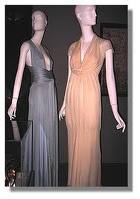
One of the most prolific and popular designers of the 1970’s was Halston. He certainly was the definitive 70’s designer and practically defined the decade with his easy to wear sports and evening wear. He was the 70’s party boy who hobnobbed with the stars at Studio 54 and was on everyones lips as well as their backs.
 Roy Halston Frowick was born on April 23, 1932 in Des Moines, Iowa. Roy developed an interest in sewing from his mother, and he began creating hats and altering clothes for his mother and sister as a child. Roy graduated Bosse High School in Evansville, Indiana in 1950, then attended Indiana University for one semester. In 1952, the family moved to Chicago, where Roy enrolled in a night course at the School of the Art Institute of Chicago and worked as a window dresser from the age of 18.
Roy Halston Frowick was born on April 23, 1932 in Des Moines, Iowa. Roy developed an interest in sewing from his mother, and he began creating hats and altering clothes for his mother and sister as a child. Roy graduated Bosse High School in Evansville, Indiana in 1950, then attended Indiana University for one semester. In 1952, the family moved to Chicago, where Roy enrolled in a night course at the School of the Art Institute of Chicago and worked as a window dresser from the age of 18. Frowick's first big break came when the Chicago Daily News ran a brief story on his fashionable hats. In 1957, he opened his first shop, the Boulevard Salon, on North Michigan Avenue. It was at this point that he began to use his middle name as his professional moniker.
Frowick's first big break came when the Chicago Daily News ran a brief story on his fashionable hats. In 1957, he opened his first shop, the Boulevard Salon, on North Michigan Avenue. It was at this point that he began to use his middle name as his professional moniker.Halston achieved great fame after designing the pillbox hat Jacqueline Kennedy wore to her husband's 1961 presidential inauguration, and when he moved to designing women's wear, Newsweek dubbed him "the premier fashion designer of all America." His designs were worn by Bianca Jagger, Liza Minnelli, Anjelica Huston, Lauren Bacall, Babe Paley, and Elizabeth Taylor, setting a style that would be closely associated with the international jet set of the era.
As "the first designer to realize the potential of licensing himself," his influence went beyond style to reshape the business of fashion. Through his licensing agreement with JC Penney, his designs were accessible to women at a variety of income levels. Although this practice is not uncommon today, it was a controversial move at the time. Halston, his perfume, was sold in a bottle designed by Elsa Peretti and was the second biggest selling perfume of all time.

Despite his achievements, his increasing drug use and failure to meet deadlines (he was reluctant to hire junior designers to design licensed products) undermined his success. In October 1984, he was fired from his own company and lost the right to design and sell clothes under his own name.
On 26 March 1990, Halston died from complications of AIDS in San Francisco, California.


Another fantastic article, JC! What a tragic end for a talented designer. It kind of makes me feel like our society doesn't quite have a place for artists and designers.
ReplyDelete